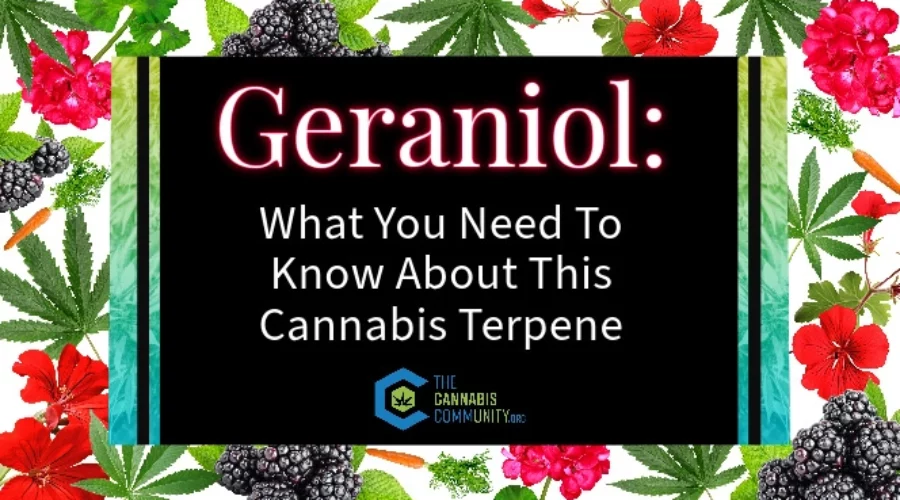Geraniol: What You Need To Know About This Cannabis Terpene
Table of Contents
Geraniol is a cannabis terpene that has been gaining a lot of attention in the medical marijuana community. With its pleasant floral aroma and potential therapeutic benefits, this terpene is becoming a popular choice among cannabis enthusiasts and medical patients alike.
As one of the many essential oils found in the cannabis plant, Geraniol is responsible for more than just the plant’s scent.
It is also believed to offer various health benefits, making it a valuable compound for both recreational and medicinal cannabis use. In this article, we will explore what Geraniol is, its presence in cannabis strains, and the potential benefits it may offer.
So, if you’re curious to learn more about this fascinating cannabis terpene, let’s dive into the world of Geraniol and discover what it has to offer.
What Are Terpenes?
Terpenes are organic compounds that can be found in cannabis and other plants. They are what give different plant species their own unique smells and tastes.
Terpenes help plants do a lot of things, like draw pollinators, keep pests away, and protect themselves from environmental stresses. They are made in structures called glandular trichomes, which look like tiny hairs and are found on the surface of plants.
Terpenes also play a role in how plants work. They can help protect plants from damage caused by sunshine and other things that cause oxidation. Terpenes might also be able to kill microorganisms, which could help plants fight off pathogens.
Terpenes are not only found in cannabis but also in many other types of plants, like fruits, vegetables, herbs, and flowers. Each plant species has its own mix and amount of terpenes, making for various smells and tastes. These aromatic compounds have been used in perfumes, aromatherapy, and traditional healing, among other things.
What Is The Entourage Effect?
The entourage effect is how different substances in cannabis — such as cannabinoids, terpenes, and other phytochemicals — work together to produce a stronger effect.
Instead of working on their own effects, these chemicals work together to improve each other’s effects and possibly improve the total therapeutic benefits.
In the case of cannabis, the entourage effect suggests that the presence of multiple cannabinoids — such as Tetrahydrocannabinol (THC) and Cannabidiol(CBD) — along with a variety of terpenes and other compounds, may have stronger effects than any one substance alone. It means that the whole plant may have more medicinal value with its complicated chemical makeup than isolated ingredients.
The entourage effect is thought to be caused by the relationships between these substances, which can change how they are absorbed, broken down, and how they affect the body’s endocannabinoid system (ECS).
What Is Geraniol?
Geraniol is a naturally occurring terpene alcohol belonging to the monoterpenes family. It is commonly found in the essential oils of numerous plants, including roses, geraniums, lemons, and, of course, cannabis.
The distinct fragrance of Geraniol is often described as a delightful blend of sweet, floral, and citrusy notes, reminiscent of roses in full bloom.
It offers a wide range of uses and benefits, making it a versatile terpene with numerous applications. Its enchanting aroma has made it a popular ingredient in perfumes, scented candles, and other fragrance products, creating an uplifting and calming atmosphere with its floral and citrusy notes. This compound is responsible for the distinctive smell of certain cannabis strains, adding a delicate and pleasant scent to the overall experience.
This terpene also plays a role in the flavor profile of cannabis, with its sweetness and floral notes enhancing the taste. When consumed — whether through smoking or ingestion — Geraniol gives the cannabis a smooth and mild flavor, often described as fruity and slightly minty. Some users may also detect a hint of citrus in the aftertaste.
Its sweet and floral notes make it a sought-after flavoring agent in the food and beverage industry, enhancing the taste of various products, including baked goods, beverages, and confectionery.
Geraniol exhibits natural insect-repellent properties, making it a common choice in mosquito repellents and citronella candles, effectively deterring pests. In terms of potential therapeutic benefits, Geraniol has been the subject of research, indicating antioxidant, anti-inflammatory, and antimicrobial properties that contribute to its health benefits. It has also shown promise in cancer research, with studies highlighting its potential anti-cancer properties, such as inhibiting cancer cell growth and inducing apoptosis.
Chemical Structure of Geraniol
Geraniol has the molecular formula C10H18O, indicating that it consists of 10 carbon (C) atoms, 18 hydrogen (H) atoms, and one oxygen (O) atom. Its structure can be visualized as a long hydrocarbon chain with a hydroxyl (-OH) group attached to one end.
The hydrocarbon chain of Geraniol consists of several carbon atoms bonded together in a linear arrangement.
At the end of the chain is a double bond between two carbon atoms, creating a point of unsaturation. This double bond is responsible for some of Geraniol’s unique properties and reactivity.
Attached to one end of the hydrocarbon chain is the hydroxyl group (-OH), consisting of an oxygen atom bonded to a hydrogen atom. This hydroxyl group contributes to the alcohol classification of Geraniol and plays a significant role in its interactions and potential biological activities.
In terms of its chemical behavior, this terpene can undergo various reactions due to its functional groups. The hydroxyl group can participate in hydrogen bonding, aiding in solubility in water and other polar solvents.
It can also undergo esterification reactions, forming esters commonly used in the production of fragrances and flavors. The double bond in the structure allows for possible addition reactions, such as hydrogenation or epoxidation.
These reactions can further modify the compound’s properties and form derivatives with different chemical and physical characteristics.
What Are the Effects of Geraniol?
This terpene may have several potential effects when consumed or applied by humans. While scientific research on the specific effects of this terpene in humans is limited, the available studies provide insights into its potential properties. It’s important to note that individual responses to Geraniol may vary, and further research is needed to fully understand its effects.
Here are some potential effects:
- Relaxation and stress relief
- Anti-inflammatory activity
- Antimicrobial and antifungal properties
- Potential pain relief
- Mood enhancement
Geraniol is primarily studied for its potential therapeutic benefits and is commonly encountered in small amounts through the consumption of foods or beverages that naturally contain this terpene. However, it is unlikely that ingesting Geraniol alone would produce noticeable psychoactive effects or significant physiological responses.
What Cannabis Strains Are High In Geraniol?
Several cannabis strains are known to contain notable levels of Geraniol and its content may vary depending on factors such as cultivation practices and genetic variations. Some cannabis strains that are often reported to have higher concentrations of Geraniol are:
- Agent Orange
- Amnesia Haze
- Black Cherry Soda
- Dutch Hawaiian
- FPOG
- Harlequin
- Kimbo Kush
- Lemon G
- OG Kush
- Purple Punch
- Sour Diesel
- Strawberry Banana
- Strawberry Diesel
- Tahoe OG
- Wedding Cake
Where Can You Find Geraniol Besides Cannabis?
Geraniol is not limited to cannabis and can be found in various natural sources. Some examples of other places where Geraniol can be found include:
- Basil
- Blackberries
- Blueberries
- Carrots
- Citronella Grass
- Coriander
- Geraniums
- Grapefruits
- Lavender
- Lemongrass
- Lemons
- Oranges
- Peaches
- Pelargoniums
- Roses
- Strawberries
Geraniol is a captivating terpene that goes beyond its aromatic allure. Its floral, sweet, and citrusy scent contributes to the rich sensory experience of cannabis strains and various other botanical sources.
Beyond its enticing fragrance, Geraniol offers potential therapeutic benefits, acts as a natural insect repellent, and finds applications in fragrance products, flavorings, and cancer research. As the world of terpenes continues to be unraveled, the aromatic marvel of this terpene remains an intriguing subject of exploration.


